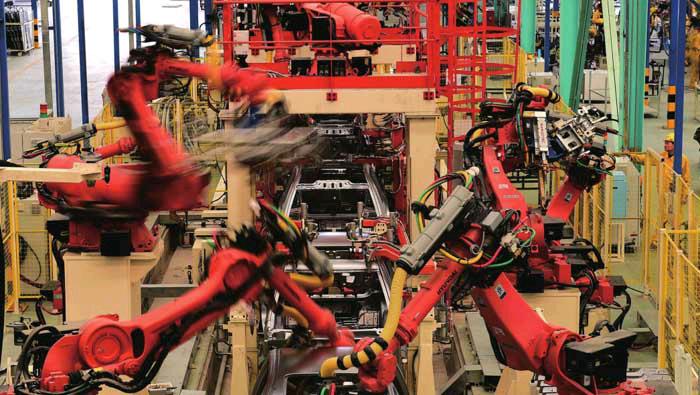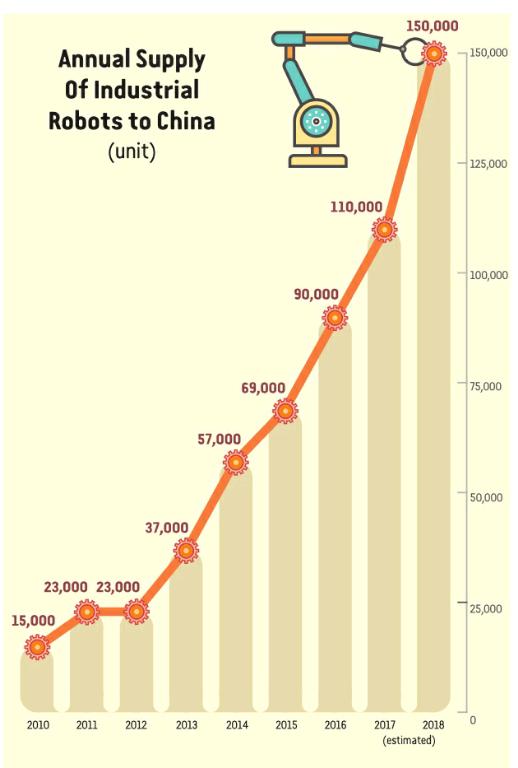Ready for Robots?
2017-07-21ByWangJun
By+Wang+Jun
In the first five months this year, Chinas output of industrial robots grew by 50.4 percent over a year ago, according to the latest figures from the National Bureau of Statistics(NBS).
As Chinas demographic dividend—a rapid increase in the proportion of working-age population—vanishes and industrial upgrading advances, labor-intensive human jobs are being taken over by robots in the Yangtze River Delta and the Pearl River Delta. Given the fact that Chinas robot density is far below the world average, this is creating unprecedented opportunities for the countrys robot industry.
Furious growth
From 2010 to 2016, Chinas industrial robot market soared fi ve-fold and since 2013, China
has become the worlds largest robot market. Its market share has risen from one fi fth of the worlds total in 2013 to one third in 2016.
According to a report by the International Federation of Robotics (IFR), 90,000 industrial robots were sold in China in 2016, surging by 31 percent, while the world average was 14 percent.
In May 2017 alone, 10,057 industrial robots were produced in China, up by 47.3 percent year on year, the NBS said.
Behind the growth speed is the upsurge in robot job takeovers. Xu Xiaolan, Secretary General of the World Robot Conference, told 21st Century Business Herald that the vanishing demographic dividend and rising labor costs are forcing manufacturing industries to replace human labor with robots.
“Also, with the manufacturing industry upgrading and production becoming increasingly sophisticated, previous manual operations are unsuitable for the new production patterns. Besides, manufacturing enterprises are unable to recruit an adequate number of workers. So, an increasing number of industrial jobs have to be done by robots,” said Xu.
Yao Zhiju, Deputy Secretary General of the China Robot Industry Alliance, told 21st Century Business Herald that at present, most robot job takeovers are occurring in the Pearl River Delta, represented by Guangzhou and Foshan in Guangdong Province, and the Yangtze River Delta, represented by Shanghai and Jiangsu Province. Robot industry leaders have a presence in both these regions.
According to Yao, the Bohai Sea Economic Rim, especially Liaoning Province and Tangshan in Hebei Province, as well as inland regions such as Chongqing Municipality, also have great potential for the development of the industrial robot industry.
“Science and technology and other capital-intensive industries have the most demand for robot workers,” Qu Daokui, Director General of the China Robot Industry Alliance and President of Shenyang-based Siasun Robot and Automation Co. Ltd., told 21st Century Business Herald.
Still, Chinas robot density, measured by the number of robots per 10,000 manufacturing workers, is far below the world average. According to the IFR, while the global robot density average reached 66 in 2015, with the density in most industrialized countries surpassing 200, in China the figure was only 36, leaving great scope for the countrys industrial robot market.
The takeover scenario
By 2020, China will triple its annual output of self-developed industrial robots to 100,000, according to a development plan for the robot industry (2016-20) jointly issued by the Ministry of Industry and Information Technology, the National Development and Reform Commission, and the Ministry of Finance in 2016.
Industrial robot sales in China will total 150,000 in 2018, and China will have more than 800,000 industrial robots by 2020, elevating its robot density to 150, according to an IFR forecast.
Is Chinas industrial robot industry ready for a massive robot job takeover? In Xus view, the Chinese robot industry is not yet mature, being fragile in independent innovation and manufacturing of core components. It has to import a large amount of core components and even complete sets of robots, which is unfavorable for domestic robot producers.
According to Xu, two major components of industrial robots, speed reducers and servo motors, are monopolized by foreign firms. Therefore, Chinese robot manufacturers have little say in price bargaining with foreign suppliers.
Xu also doesnt agree that robot job takeovers will increase unemployment since they are the result of the dwindling labor force. Chinese manufacturers urgently need to train new technical workers to boost industrial upgrading.
According to Qu, China-produced robots are not for the high-end market. While foreign fi rms hold an 80 to 90 percent market share in robots capable of sophisticated maneuvers, China-made robots are mainly used for simple operations such as carrying, arranging and material handling.
Excessive low-end production could also be a problem for Chinas robot industry.
Li Dong, Director of the Industrial Equipment Department at the Ministry of Industry and Information Technology, said there are now more than 800 robot manufacturers in China, of which 200 produce the main bodies while the others are mainly engaged in assembly or material processing.
“At the low end of the industrial chain, Chinese robot producers have low industrial concentration and are small in size. China has over 40 industrial parks for manufacturing robots, intensifying the risk of excessive low-end production,” Li said at a press briefing held in June 2016.
“Instead of job takeovers, we should be more concerned about whether Chinas robot industry, given the huge domestic market, is capable of independent innovation and seizing the market,” Xu said.
